
PUIJALON Sara DR-CNRS
Chercheur : EVZH
Responsable EVZH (Ecologie Végétale et Zones Humides)
Responsable scientifique : Canal Hydraulique , Espace Expérimental des étangs
Université Lyon 1
CNRS, UMR 5023 - LEHNA,
Laboratoire d'Ecologie des Hydrosystèmes Naturels et Anthropisés
6, rue Raphaël Dubois - Bât. Forel
F-69622 Villeurbanne Cedex FRANCE
(+33) 04 72 43 14 31 (+33) 04 72 43 11 41
Cette adresse e-mail est protégée contre les robots spammeurs. Vous devez activer le JavaScript pour la visualiser.

- MOTS CLESVégétation aquatique ; écologie physique ; éco-hydraulique ; biomécanique ; stress et perturbations ; stratégies adaptatives ; traits fonctionnels ; plasticité phénotypique ; éco-morphologie ; morphométrie ; organismes ingénieurs.ACTIVITES de RECHERCHEMes activités de recherche portent sur l’étude des interactions entre la végétation aquatique et les contraintes physiques. La principale contrainte physique considérée est la contrainte hydrodynamique (courant, vagues, crues…), en abordant des problématiques portant sur la réponse des végétaux à cette contrainte et des problématiques portant sur l’effet de la végétation sur les écoulements et les processus qui sont liés (e.g. dynamique sédimentaire). En lien avec ces problématiques éco-hydrauliques, je développe également des projets sur la dispersion des végétaux (notamment les aspects physiques de la dispersion) en milieu aquatique. Je développe également des projets sur la réponse des végétaux à d’autres types de contraintes physiques, en particulier les contraintes mécaniques liées aux variations de niveau d’eau (modification de la portante et des contraintes gravitationnelles) et sur les rôles fonctionnels des traits biomécaniques foliaires. Quelle que soit la contrainte physique étudiée, l’objectif est d’intégrer la réponse de la végétation dans un cadre plus large, aussi bien en ce qui concerne le déterminisme de la réponse des végétaux, les interactions entre les contraintes physiques et d’autres contraintes ou les conséquences fonctionnelles de ces réponses.Quelques RESULTATS RECENTSRésistance aux contraintes hydrodynamiques élevées (perturbations).Les plantes aquatiques soumises à des mouvements d’eau (courant, vagues) subissent des forces hydrodynamiques qui tendent à les briser ou à les déraciner. La capacité des plantes à résister à ces forces sans subir de dégâts dépend de leur capacité à minimiser les forces subies (traînée) ou à maximiser leur résistance à la brisure.
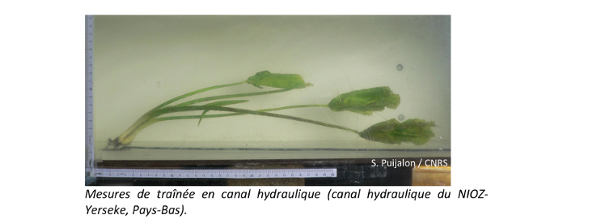
L’étude des stratégies de résistance à des vitesses de courant élevées chez une trentaine d’espèces de plantes aquatiques a permis de démontrer une corrélation négative entre les stratégies d’évitement (capacité à minimiser les forces subies) et tolérance (capacité à supporter des forces élevées sans subir de brisure), à la fois pour les traits bruts et les contrastes phylogénétiquement indépendants (Puijalon et al. 2011). Il existe donc une contrainte, et potentiellement un compromis, limitant la capacité des espèces à maximiser les 2 stratégies simultanément et donc, leur résistance globale aux contraintes hydrodynamiques.
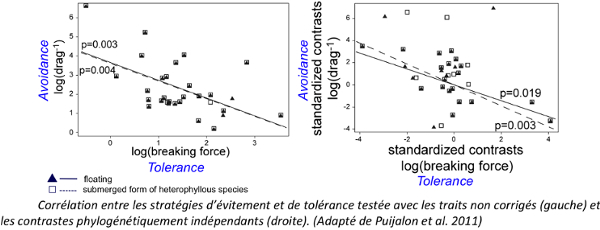
Réponses plastiques au stress hydrodynamiqueDe nombreuses espèces de plantes aquatiques présentent des réponses plastiques au courant importantes, par exemple pour les traits morphologiques, clonaux. Nous avons testé l’effet du stress hydrodynamique (agitation de l’eau) sur l’allocation aux différents types de tissus et les conséquences pour les propriétés biomécaniques des organes (force de brisure, contrainte de rupture, flexibilité).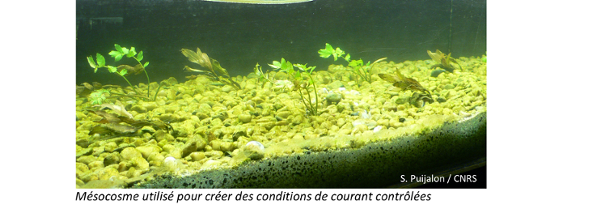
Ces résultats démontrent que les végétaux aquatiques, qui ont généralement peu de tissus de soutien, peuvent, en réponse à une simulation mécanique, présenter une augmentation de l’allocation aux tissus de soutien, conduisant à un phénotype plus résistant mécaniquement (Schoelynck et al., 2015).
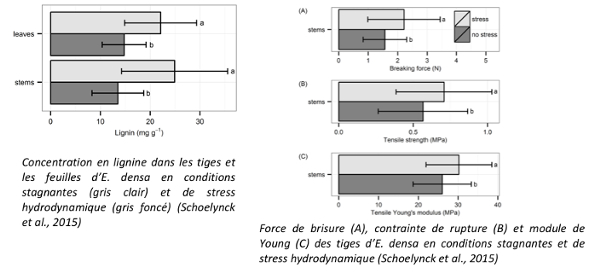
Réponses à des stress multiples
En conditions naturelles, les plantes sont fréquemment soumises à plusieurs stress environnementaux qui s’exercent simultanément, mais qui, généralement, n’agissent pas indépendamment sur les plantes, un facteur pouvant modifier la capacité à tolérer ou à répondre à un autre facteur.
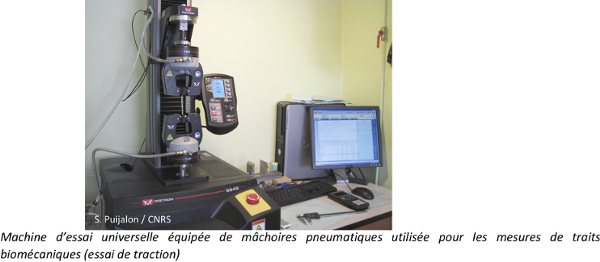
Nous avons démontré que l’augmentation de la concentration en nutriments conduit, chez certaines espèces de végétaux aquatiques à la production de tissus moins denses et à des changements anatomiques (réduction de la surface relative du cylindre centrale et augmentation de la taille des lacunes de l’aérenchyme) correspondant à des adaptations à l’augmentation du niveau trophique. Cependant, ces réponses conduisent à une baisse importante de la résistance mécanique des plantes : en conditions de trophie élevée, les tiges des 2 espèces présentent une réduction de la force de brisure, de la contrainte de rupture et une augmentation de la flexibilité (Lamberti-Raverot et Puijalon, 2012).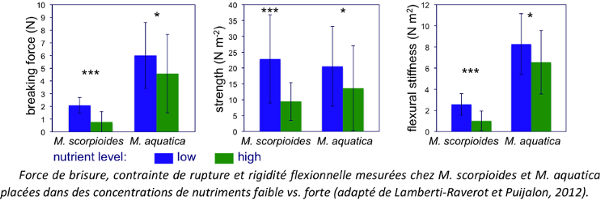
- Directrice de Recherche CNRS
DEROULEMENT DE CARRIERE
Depuis 2019 : Directrice de Recherche
11 Juillet 2017 : Habilitation à Diriger des Recherches
2008-2019 : Chargée de Recherche CNRS
2007-2008 Post-doctorat Netherlands Institute of Ecology, Centre for Estuarine and Marine Ecology (NIOO-KNAW), Yerseke, Pays-Bas.
2005-2007 Post-doctorat. Université Lyon1
2005 : Thèse de doctorat : Stratégies adaptatives des végétaux aquatiques et stress mécaniques: réponses morphologiques et plasticité phénotypique (Université Lyon 1)
Senior Scientist CNRS
PROFESSIONAL EXPERIENCE
Since 2019 : Senior Scientist CNRS
11 July 2017 : habilitation to supervise research
2008-2019 : Associate Scientist CNRS
2007-2008: Post-doc position: Netherlands Institute of Ecology, Centre for Estuarine and Marine Ecology (NIOO-KNAW), Yerseke, The Netherlands
2005-2007: Post-doc position: University Lyon 1 (France)
2005 : PhD thesis : Adaptations of aquatic plants to mechanical stress : morphological responses and phenotypic plasticity (University Lyon 1, France)d - Sous Presse Cao, Y., Barbiero, P., Briat, F., Camenen, B., Chambat, F., [...], Puijalon, S., [...], Volatier, F., Zanot, J.M. Reimagining Urban River Bathing in Europe: A Multisectoral and Interdisciplinary Dive Into Lyon's Rivers (France). River Research and Applications, ⟨10.1002/rra.70050⟩. ⟨hal-05304137⟩2024 Clausse, M., Lefèvre, F., Jovet, Y., Fontaine, A., [...], Puijalon, S., 2024 - River water heat pumps to decarbonise district heating and promote the resilience of hydrosystems: Technico-economic, environmental and sociological challenges. Energy Nexus, 16, pp.100325. ⟨10.1016/j.nexus.2024.100325⟩2024 Godfroy, J., Malherbe, P., Gerle, F., Marteau, B., [...], Puijalon S., [...], Piegay, H., 2024 - Can Multiscale Thermal Infrared Imaging Help Validate and Monitor Water Stress in Alluvial Forests?. Ecohydrology, pp.e2710. ⟨10.1002/eco.2710⟩.2024 Lochin, P., Malherbe, P., Marteau, B., [...] Godfroy, J., Puijalon, S., [...] Vernay, A., 2024 -The ant and the grasshopper: Contrasting responses and behaviors to water stress of riparian trees along a hydroclimatic gradient. Science of the Total Environment, 952, pp.175916. ⟨10.1016/j.scitotenv.2024.175916⟩2023 Cornacchia, L., Lapetoule, G., Licci, S., Basquin, H., Puijalon, S., 2023 - How to build vegetation patches in hydraulic studies: a hydrodynamic-ecological perspective on a biological object. Journal of Ecohydraulics, 8 (2), pp.105-120. ⟨10.1080/24705357.2023.2176375⟩2023 Fronhofer, E., Corenblit, D., Deshpande, J.N., Govaert, L., Huneman, P., Viard, F., Jarne, P., Puijalon, S., 2023 - Eco‐evolution from deep time to contemporary dynamics: The role of timescales and rate modulators. Ecology Letters, 26 (S1), ⟨10.1111/ele.14222⟩2022 Cornacchia, L., Riviere, N., Soundar Jerome, J.J., Doppler, D., Vallier, F., Puijalon, S., 2022 - Flow and Wake Length Downstream of Live Submerged Vegetation Patches: How Do Different Species and Patch Configurations Create Sheltering in Stressful Habitats?. Water Resources Research, 58 (3), pp.e2021WR030880. ⟨10.1029/2021WR030880⟩2022 Licci, S., Marmonier, P., Wharton, G., Delolme, C., Mermillod-Blondin, F., Simon, L., Vallier, F., Bouma, T.J., Puijalon, S., 2022 - Scale-dependent effects of vegetation on flow velocity and biogeochemical conditions in aquatic systems. Science of the Total Environment, 833, pp.155123. ⟨10.1016/j.scitotenv.2022.155123⟩2022 Nepf, H., Puijalon, S., Capra, H., 2022 - Organism-scale interaction with hydraulic conditions. Journal of Ecohydraulics, 7 (1), pp.1-3. ⟨10.1080/24705357.2022.2042919⟩2021 Galland, W., Haichar, F.E.Z., Czarnes, S., Mathieu, C., Demorge, J.L., Simon, L., Puijalon, S., Piola, F., 2021 - Biological inhibition of denitrification (BDI) in the field: Effect on plant growth in two different soils. Applied Soil Ecology, 159, 103857. ⟨10.1016/j.apsoil.2020.103857⟩2021 Kwon, T., Shibata, H., Kepfer-Rojas, S., Kappel Schmidt, I., Steenberg Larsen, K., Beier, C., Berg, B., Verheyen, K., Lamarque, J.F., Hagedorn, F., Eisenhauer, N., Djukic, I. [...] Marmonier, P., [...] Puijalon, S. et al., 2021 - Effects of climate and atmospheric nitrogen deposition on early to mid-term stage litter decomposition across biomes. Frontiers in Forests and Global Change, 4:18. (10.3389/ffgc.2021.678480)2021 Mondy, N., Boisselet, C., Poussineau, S., Vallier, F., Lengagne, T., Secondi, J., Romestaing, C., Geay, M., Puijalon, S., 2021 - Herbivory increases on freshwater plants exposed to artificial light at night. Aquatic Botany, 175, pp.103447. ⟨10.1016/j.aquabot.2021.103447⟩2021 Navratil, O., Brekenfeld, N. Puijalon, S., Sabastia, M., Boyer, M., Pella, H., Lejot, J., Piola, F., 2021 - Distribution of Asian knotweeds on the Rhône River basin, France: A multi-scale model of invasibility that combines biophysical and anthropogenic factors. Science of the Total Environment 763, 142995. (10.1016/j.scitotenv.2020.142995)2021 Saiz, H., Renault, D., Puijalon, S., Barrio, M., Bertrand, M., Tolosano, M., Pierre, A., Ferreira, C., Prouteau, C., Bittebiere, A.K., 2021 - Huff and puff and blow down: invasive plants traits response to strong winds at the Southern Oceanic Islands. Oikos, 130, pp.1919-1929. ⟨10.1111/oik.08249⟩2021 Segrestin, J., Mondy, N., Boisselet, C., Guigard, L., Lengagne, T., Poussineau, S., Secondi, J., Puijalon, S., 2021 - Effects of artificial light at night on the leaf functional traits of freshwater plants. Freshwater Biology, 66, 2264-2271. ⟨10.1111/fwb.13830⟩2020 Schoelynck, J.,Wolters, J.W., Teuchies, J., Brion, N., Puijalon, S., Horemans, D.M.L., Keirsebelik, H., Bervoets, L., Blust, R., Meire, P., 2020 - Experimental evidence for the decline of submerged vegetation in freshwater ecosystems by the invasive Chinese mitten crab (Eriocheir sinensis). Biological Invasions, 22 : 627–641.2019 Cornacchia, L. , Folkard, A. , Davies, G., Grabowski, R. C., van de Koppel, J. , van der Wal, D. , Wharton, G., Puijalon, S., Bouma, T. J., 2019 - Plants face the flow in V formation: A study of plant patch alignment in streams. Limnology and Oceanography, 64 : 1087-1102.2019 Cornacchia, L. , Licci, S. , Nepf, H. , Folkard, A. , Wal, D. , Koppel, J. , Puijalon, S., Bouma, T. J., 2019 - Turbulence‐mediated facilitation of resource uptake in patchy stream macrophytes. Limnology and Oceanography, 64 : 714-727.2019 Cornacchia, L. , van der Wal, D. , van de Koppel, J. , Puijalon, S. , Wharton, G., Bouma, T. J., 2019 - Flow-divergence feedbacks control propagule retention by in-stream vegetation: the importance of spatial patterns for facilitation. Aquatic Sciences, 81 : 1-17.
2019 Galland, W., Piola, F., Burlet, A., Mathieu, C., Nardy, M., Poussineau, S., Blazère, L., Gervaix, J., Puijalon, S., Simon, L., Haichar, F.E.Z., 2019 - Biological denitrification inhibition (BDI) in the field: A strategy to improve plant nutrition and growth. Soil Biology and Biochemistry, 136, 107513 : 1-9.2019 Lamberti-Raverot, B., Piola, F., Vallier, F., Gardette, V., Puijalon, S., 2019 - Achene traits involved in the water dispersal of the invasive Fallopia × bohemica complex: Variability and dispersal strategies. Flora, 251 : 88-94.2019 Licci, S., Nepf, H., Delolme, C., Marmonier, P., Bouma, T.J., Puijalon, S., 2019 - The role of patch size in ecosystem engineering capacity: a case study of aquatic vegetation. Aquatic Sciences, 81(41) : 1-11.2019 Marjoribanks, T.I., Lague, D., Hardy, R.J., Boothroyd, R.J., Leroux, J., Mony, C., Puijalon, S., 2019 - Flexural Rigidity and Shoot Reconfiguration Determine Wake Length Behind Saltmarsh Vegetation Patches. Journal of Geophysical Research: Earth Surface, 124, 2176–2196.2019 Navratil, O., Lejot, J., Rachex, D., Puijalon, S., Piola, F., 2019 - Apport de la télédétection pour l’inventaire des renouées du Japon le long des cours d’eau : exemple d’application à la rivière Azergues. Sciences Eaux & Territoires, 27 : 50-53.2019 Puijalon, S., Rouifed, S., Thiébaut, M., Lamberti-Raverot, B., Piola, F., 2019 - Dispersion par les cours d’eau des propagules végétatives et sexuées du complexe d’espèces Reynoutria. Sciences Eaux & Territoires, 27 : 34-37.2018 Cornacchia, L., Van De Koppel, J., Van Der Wal, D., Wharton, G., Puijalon, S., Bouma, T.J., 2018 - Landscapes of facilitation: how self-organized patchiness of aquatic macrophytes promotes diversity in streams. Ecology, 99(4) : 832–847.2018 Djukic, I., Kepfer-Rojas, S., Schmidt, I. K., Larsen, K. S., Beier, C., Berg, B., Verheyen, K., et al., 2018 - Early stage litter decomposition across biomes. Science of the Total Environment, 628-629 :1369-1394.2018 Gippet, J.M.W., Piola, F., Rouifed, S., Viricel, M.R., Puijalon, S., Douady, C.J., Kaufmann, B., 2018 - Multiple invasions in urbanized landscapes: interactions between the invasive garden ant Lasius neglectus and Japanese knotweeds (Fallopia spp.). Arthropod-Plant Interactions, 12 : 351–360.2018 O’Hare, M.T., Aguiar, F.C. , Asaeda, T., Bakker, E.S., Chambers, P.A., Clayton, J., Elger, A., Ferreira, T.T., Gross, E.M., Gunn, I.D.M., Gurnell, A.M., Hellsten, S., Hofstra, D., Li, W., Mohr, S., Puijalon, S., Szoszkiewicz, K., Willby, N.J., Wood, K.J., 2018 - Plants in aquatic ecosystems: current trends and future directions. Hydrobiologia, 812 : 1-11.2018 Rouifed, S., Puijalon, S., Bardon, C., Meiffren, G., Buonomo, A., Sebei, N., Poussineau, S., Vallier, F., Shimoda, M., Piola, F., 2018 - Comparison of defence and performance traits between one widespread clone and native populations in a major invasive plant species. Diversity and Distributions, 24 : 297–312.2018 Silinski, A., Schoutens, K., Puijalon, S., Schoelynck, J., Luyckx, D., Troch, P., Meire, P., Temmerman, S., 2018 - Coping with waves : plasticity in tidal marsh plants as self-adapting coastal ecosystem engineers. Limnology and Oceanography, 63 : 799–815.2017 De Wilde, M., Puijalon, S., Bornette, G., 2017 - Sediment type rules the response of aquatic plant communities to dewatering in wetlands. Journal of Vegetation Science, 28 : 172-183.2017 Desprat, J.L., Teulier, L., Puijalon, S., Dumet, A., Romestaing, C., Tattersall, G.J., Lengagne, T., Mondy, N., 2017 - Doping for sex: bad for mitochondrial performances ? Case of testosterone supplemented Hyla arborea during the courtship period. Comparative Biochemistry and Physiology Part A, 209 : 74-83.2017 Favre-Bac, L., Lamberti-Raverot, B., Puijalon, S., Ernoult, A., Burel, F., Guillard, L., Mony, C., 2017 - Plant dispersal traits determine hydrochorous species tolerance to connectivity loss at the landscape scale. Journal of Vegetation Science. Journal of Vegetation Science, 28 : 605–615.2017 Lamberti-Raverot, B., Piola, F., Thiébaut, M., Guillard, L., Vallier, F., Puijalon, S., 2017 - Water dispersal of the invasive complex Fallopia: the role of achene morphology. Flora, 234 : 150-157.2017 Philippe, M., Puijalon, S., Suan, G., Mousset, S., Thévenard, F., Mattioli, E., 2017 - The palaeolatitudinal distribution of fossil wood genera as a proxy for European Jurassic terrestrial climate. Palaeogeography, Palaeoclimatology, Palaeoecology, 466 : 373–381.2017 Rendu, Q., Mignot, E., Riviere, N., Lamberti-Raverot, B., Puijalon, S. Piola, F., 2017 - Laboratory investigation of Fallopia x bohemica fruits dispersal by watercourses. Environmental Fluid Mechanics, 17 : 1051–1065.2016 Foucreau, N., Piscart, C., Puijalon, S., Hervant, F., 2016 - Effects of rising temperature on a functional process: consumption and digestion of leaf litter by a freshwater shredder. Fundamental and Applied Limnology, 187(4) : 295-306.2016 Ganie, A.H., Reshi, Z.A., Wafai, B.A., Puijalon, S., 2016 - Clonal growth architecture and spatial dynamics of 10 species of the genus Potamogeton across different habitats in Kashmir valley, India. Hydrobiologia, 767 : 289–299.2016 Silinski, A., Heuner, M., Troch, P., Puijalon, S., Bouma , T.J., Schoelynck, J., Schröder, U., Fuchs, E., Meire, P., Temmerman, S., 2016 - Effects of contrasting wave conditions on scour and drag on pioneer tidal marsh plants. Geomorphology, 255 : 49–62.2015 Christina, M., Rouifed, S., Puijalon, S., Vallier, F., Meiffren, G., Bellvert, F., Piola, F., 2015 - Allelopathic effect of a native species on a major plant invader in Europe. The Science of Nature, 102 : 1-12.
2015 De Wilde, M., Puijalon, S., Vallier, F., Bornette, G., 2015 - Physico-chemical consequences of water-level decreases in wetlands. Wetlands, 35 : 683–694.
2015 Heuner, M., Silinski, A., Schoelynck, J., Bouma, T.J., Puijalon, S., Troch, P., Fuchs, E., Schröder, B., Schröder, U., Meire, P., Temmerman, S., 2015 - Ecosystem engineering by plants on wave-exposed intertidal flats is governed by relationships between effect and response traits. PLoS One, 10(9 ): e0138086.
2015 Schoelynck, J., Puijalon, S., Meire, P., Struyf, E., 2015 - Thigmomorphogenetic responses of an aquatic macrophyte to hydrodynamic stress. Frontiers in Plant Science, 6(43) : 1-7.
2015 Silinski, A., Heuner, M., Schoelynck, J., Puijalon, S., Schröder, U., Fuchs, E., Troch, P., Bouma, T.J., Meire, P., Temmerman, S., 2015 - Effects of wind waves versus ship waves on tidal marsh plants : a flume study on different life stages of Scirpus maritimus. PlosOne, 10(3) : 1-16.
2014 Bardon, C., Piola, F., Bellvert, F., El Zahar Haichar, F., Comte, G., Meiffren, G., Pommier, T., Puijalon, S., Tsafack, N., Poly, F., 2014 - Evidence for biological denitrification inhibition (BDI) by plant secondary metabolites. New Phytologist, 204 : 620–630.
2014 De Wilde, M., Sebei, N., Puijalon, S., Bornette, G., 2014 - Responses of macrophytes to dewatering: effects of phylogeny and phenotypic plasticity on species performance. Evolutionary Ecology, 28 : 1155-1167.
2014 Ganie, A.H., Reshia, Z.A., Wafaia, B.A., Puijalon, S., 2014 - Phenotypic plasticity : Cause of the successful spread of the genus Potamogeton in the Kashmir Himalaya. Aquatic Botany 120 : 283–289.
2014 Marion, A., Nikora, V., Puijalon, S., Bouma, T., Koll, K., Ballio, F., Tait, S., Zaramella, M., Sukhodolov, A., O’Hare, M., Wharton, G., Aberle, J., Tregnaghi, M., Davies, P., Nepf, H., Parker, G., Statzner, B., 2014 - Aquatic interfaces: a hydrodynamic and ecological perspective. Journal of Hydraulic Research, 52(6) : 744–758.2014 Thomas, R.E. (IAHR member), Johnson, M.F., Frostick L.E. (IAHR member), Parsons, D.R., Bouma, T.J., Dijkstra, J.T., Eiff, O., Gobert, S., Henry, P.Y., Kemp, P., McLelland, S.J., Moulin, F.Y. (IAHR member), Myrhaug, D., Neyts, A., Paul, M., Penning, W.E., Puijalon, S., Rice, S.P., Stanica, A., Tagliapietra, D., Tal, M., Torum, A., Vousdoukas, M.I., 2014 - Physical modelling of water, fauna and flora: knowledge gaps, avenues for future research and infrastructural needs. Journal of Hydraulic Research, 52(3) : 311–325.
2013 Dehedin, A., Maazouzi, C., Puijalon, S., Marmonier, P., Piscart, C., 2013 – The combined effects of water level reduction and an increase in ammonia concentration on organic matter processing by key freshwater shredders in alluvial wetlands. Global Change Biology, 19 : 763–774.2013 Foucreau, N., Piscart, C., Puijalon, S., Hervant, F., 2013 - Effect of Climate-Related Change in Vegetation on Leaf Litter Consumption and Energy Storage by Gammarus pulex from Continental or Mediterranean Populations. PLoS One, 8(10) e77242 : 1-9.2013 Foucreau, N., Puijalon, S., Hervant, F., Piscart, C., 2013 - Effect of leaf litter characteristics on leaf conditioning and on consumption by Gammarus pulex. Freshwater Biology, 58 : 1672–1681.
2013 Hamann, E., Puijalon, S., 2013 - Biomechanical responses of aquatic plants to aerial conditions. Annals of Botany, 112 : 1869-1878.
2013 Ibanez, S., Lavorel, S., Puijalon, S., Moretti, M., 2013 - Herbivory mediated by coupling betweenbiomechanical traits of plants and grasshoppers. Functional Ecology, 27 : 479–489.
2012 Lamberti-Raverot, B., Puijalon, S., 2012 – Nutrient enrichment affects the mechanical resistance of aquatic plants. Journal of Experimental Botany, 63(17) : 6115-6123.
2012 Schoelynck, J., Bal, K., Puijalon, S., Meire, P., Struyf, E., 2012 - Hydrodynamically mediated macrophyte silica dynamics. Plant Biology, 14 : 997–1005.
- Revues professionnelles ou techniques 2019 - Navratil, O., Lejot, J., Rachex, D., Puijalon, S., Piola, F. Apport de la télédétection pour l’inventaire des renouées du Japon le long des cours d’eau : exemple d’application à la rivière Azergues. Sciences Eaux & Territoires, 27 : 50-53.- Revues professionnelles ou techniques 2019 - Puijalon, S., Rouifed, S., Lamberti-Raverot, B., Thiébaut, M., Piola, F. Dispersion par les cours d’eau des propagules végétatives et sexuées du complexe d’espèces Reynoutria. Sciences Eaux & Territoires, 27 : 34-37.- Autres productions 2016 - Cornacchia, L., Licci, S., van de Koppel, J., van der Wal, D., Wharton, G., Puijalon, S., Bouma, T. Flow velocity and morphology of a submerged patch of the aquatic species Veronica anagallis-aquatica L. P.M. Rowinski and A. Marion (eds.), Hydrodynamic and Mass Transport at Freshwater Aquatic Interfaces, GeoPlanet: Earth and Planetary Sciences.- Autres productions 2016 - Licci, S., Delolme, C., Marmonier, P., Philippe, M., Cornacchia, L., Gardette, V., Bouma, T., Puijalon, S. Effect of aquatic plant patches on flow and sediment: the case of Callitriche platycarpa and Elodea nuttallii. P.M. Rowinski and A. Marion (eds.), Hydrodynamic and Mass Transport at Freshwater Aquatic Interfaces, GeoPlanet: Earth and Planetary Sciences.2011
Puijalon, S., Bouma, T.J., Douady, C.J., van Groenendael, J., Anten, N.P.R., Martel, E. & Bornette, G. 2011. Plant resistance to mechanical stress : evidence of an avoidance-tolerance trade-off. New Phytologist, 191 : 1141-1149.
Rouifed, S., Puijalon, S., Viricel, M.-R. & Piola, F. 2011. Achene buoyancy and germinability of the terrestrial invasive Fallopia x bohemica in aquatic environment : a new vector of dispersion ? Ecoscience, 18 : 79-84
Mony, C., Puijalon, S. & Bornette, G. 2011. Response of clonal plants to disturbances : does resprouting pattern determine ecological niche ? Folia Geobotanica, 46: 155-164
Bornette, G. & Puijalon, S. 2011. Response of aquatic plants to abiotic factors: a review. Aquatic Sciences, 73: 1-14.
2009
Bornette, G. & Puijalon, S. 2009. Macrophytes: ecology of aquatic plants. In: Encyclopedia of Life Sciences (ELS), John Wiley & Sons, Ltd: Chichester.
Benot, M.-L., Mony, C., Puijalon, S., Esmaeili, M.M., Van Alphen, J.J.M, Bouzillé, J.-B. & Bonis, A. 2009. Responses of clonal architecture to experimental defoliation: a comparative study between ten grassland species, Plant Ecology, 201: 621-630.
2008
Puijalon, S., Bouma, T.J., van Groenendael, J. & Bornette, G. 2008. Clonal plasticity of aquatic plant species submitted to mechanical stress: escape vs. resistance strategy, Annals of Botany, 102: 989-996.
Bornette, G., Tabacchi, E., Hupp, C., Puijalon, S. & Rostan, J.-C. 2008. A model of plant strategies in fluvial hydrosystems, Freshwater Biology, 53: 1692-1705.
Puijalon, S., Léna, J.-P., Rivière, N., Champagne, J.-Y., Rostan, J.-C. & Bornette, G. 2008. Phenotypic plasticity in response to mechanical stress: hydrodynamic performance and fitness of 4 aquatic plant species, New Phytologist, 177: 907-917.
Puijalon, S., Piola, F. & Bornette, G. 2008. Abiotic stresses increase plant regeneration ability, Evolutionary Ecology, 22: 493-506.
2007
Puijalon, S., Léna, J.-P. & Bornette, G. 2007. Interactive effects of nutrient and mechanical stresses on plant morphology, Annals of Botany 100: 1297-1305.
2006
Puijalon, S. & Bornette, G. 2006. Phenotypic plasticity and mechanical stress: biomass partitioning and clonal growth of an aquatic plant species, American Journal of Botany 93: 1090-1099
2005
Puijalon, S., Bornette, G. & Sagnes, P. 2005. Adaptations to increasing hydraulic stress: morphology, hydrodynamics and fitness of two higher aquatic plant species, Journal of Experimental Botany 56: 777-786.
2004
Puijalon, S. & Bornette, G. 2004. Morphological variation of two taxonomically distant plant species along a natural flow velocity gradient, New Phytologist 163 : 651-660.
2002
Barrat-Segretain, M-H., Elger, A., Sagnes, P. & Puijalon, S. 2002. Comparison of three life-history traits of invasive Elodea canadensis Michx. and Elodea nuttallii (Planch.) H. St. John, Aquatic Botany 74 : 299-313. - Chapitres d'ouvrages
2016 - Cornacchia, L., Licci, S., van de Koppel, J., van der Wal, D., Wharton, G., Puijalon, S., Bouma, T. Flow velocity and morphology of a submerged patch of the aquatic species Veronica anagallis-aquatica L. P.M. Rowinski and A. Marion (eds.), Hydrodynamic and Mass Transport at Freshwater Aquatic Interfaces, GeoPlanet: Earth and Planetary Sciences.
2016 - Licci, S., Delolme, C., Marmonier, P., Philippe, M., Cornacchia, L., Gardette, V., Bouma, T., Puijalon, S. Effect of aquatic plant patches on flow and sediment: the case of Callitriche platycarpa and Elodea nuttallii. P.M. Rowinski and A. Marion (eds.), Hydrodynamic and Mass Transport at Freshwater Aquatic Interfaces, GeoPlanet: Earth and Planetary Sciences.
2013 - Puijalon, S., Bornette, G. Multi-scale macrophyte responses to hydrodynamic stress and disturbances: adaptive strategies and biodiversity patterns. In : Ecohydraulics: an integrated approach, Edited by: Maddock, I., Harby, A., Kemp, P. & Wood, P. John Wiley & Sons, Ltd. Chichester, UK. ISBN 978-0-470-97600-5.































